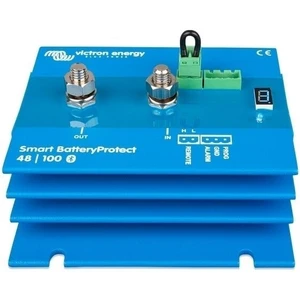Protects the battery against excessive discharge and can be used as a system on/off switchThe Smart BatteryProtect disconnects the battery from non-essential loads before it is completely discharged (which would damage the battery) or before it has insufficient power left to crank the engine. The on/off input can be used as a system on/off switch.
12/24 V auto rangingThe Smart BatteryProtect automatically detects system voltage one time only.
Bluetooth: programming made easyWhen using Bluetooth to program the Smart BatteryProtect any required engage/disengage levels can be set. Alternatively, one of nine predefined engage/disengage levels can be set with the programming pin (see manual). If required, Bluetooth can be disabled.
A special setting for Li-ion batteriesIn t his mode the BatteryProtect can be controlled by the VE.Bus BMS.Note: the BatteryProtect can also be used as a charge interrupter in between a battery charger and a Li-ion battery. See connection diagram in the manual.
Ultra-low current consumptionThis is important in case of Li-ion batteries, especially after low voltage shutdown.
Over voltage protectionTo prevent damage to sensitive loads due to over voltage, the load is disconnected whenever the DC voltage exceeds 16.3 V respectively 32.6 V.
Ignition proofNo relays but MOSFET switches, and therefore no sparks.
Delayed alarm outputThe alarm output is activated if the battery voltage drops below the preset disconnect level during more than 12 seconds. Starting the engine will therefore not activate the alarm. The alarm output is a short circuit proof open collector output to the negative (minus) rail, max. current 50 mA. The alarm output is typically used to activate a buzzer, LED or relay.
Delayed load disconnect and delayed reconnectThe load will be disconnected 90 seconds after the battery voltage drops below the preset level. If the battery voltage increases again to the connect threshold within this time period (after the engine has been started for example), the load will not be disconnected. The load will be reconnected 30 seconds after the battery voltage has increased to more than the preset reconnect voltage.
Made in: Netherlands
Current: 100 A
Voltage: 48 V
Current (A): 100.0 más
12/24 V auto rangingThe Smart BatteryProtect automatically detects system voltage one time only.
Bluetooth: programming made easyWhen using Bluetooth to program the Smart BatteryProtect any required engage/disengage levels can be set. Alternatively, one of nine predefined engage/disengage levels can be set with the programming pin (see manual). If required, Bluetooth can be disabled.
A special setting for Li-ion batteriesIn t his mode the BatteryProtect can be controlled by the VE.Bus BMS.Note: the BatteryProtect can also be used as a charge interrupter in between a battery charger and a Li-ion battery. See connection diagram in the manual.
Ultra-low current consumptionThis is important in case of Li-ion batteries, especially after low voltage shutdown.
Over voltage protectionTo prevent damage to sensitive loads due to over voltage, the load is disconnected whenever the DC voltage exceeds 16.3 V respectively 32.6 V.
Ignition proofNo relays but MOSFET switches, and therefore no sparks.
Delayed alarm outputThe alarm output is activated if the battery voltage drops below the preset disconnect level during more than 12 seconds. Starting the engine will therefore not activate the alarm. The alarm output is a short circuit proof open collector output to the negative (minus) rail, max. current 50 mA. The alarm output is typically used to activate a buzzer, LED or relay.
Delayed load disconnect and delayed reconnectThe load will be disconnected 90 seconds after the battery voltage drops below the preset level. If the battery voltage increases again to the connect threshold within this time period (after the engine has been started for example), the load will not be disconnected. The load will be reconnected 30 seconds after the battery voltage has increased to more than the preset reconnect voltage.
Made in: Netherlands
Current: 100 A
Voltage: 48 V
Current (A): 100.0 más
